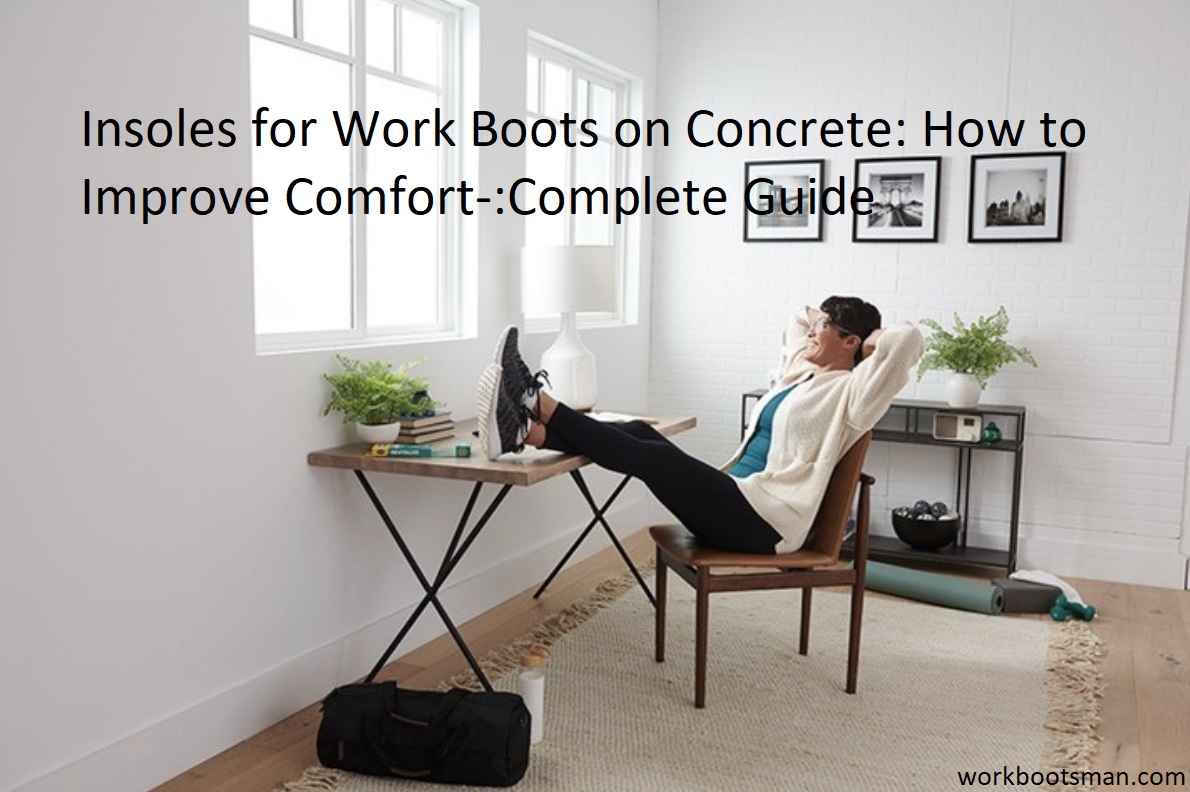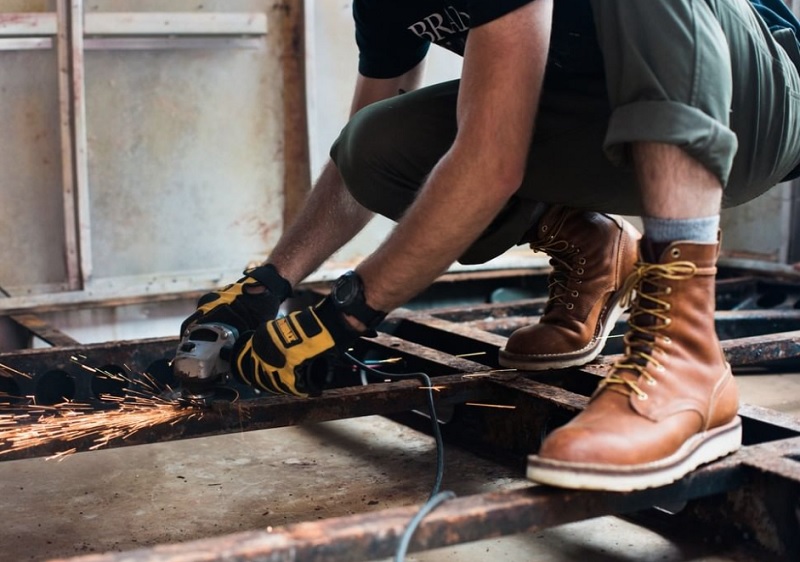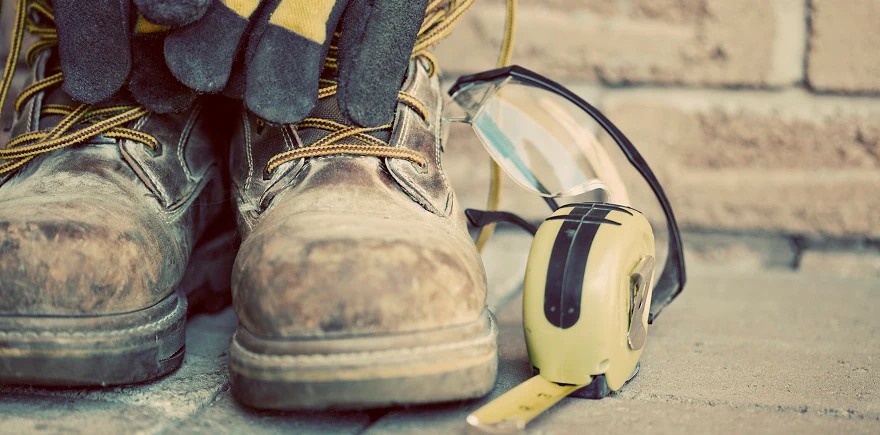Are you tired of aching feet after a hard day’s work, wearing your work boots on concrete? Discover how to improve comfort with insoles for work boots designed to cushion and protect your feet.
In this comprehensive guide, we’ll show you how to find the best insoles for your work boots.
Getting the right boots for work is essential to providing your feet with the best possible level of comfort and protection throughout long shifts spent standing or walking on hard surfaces such as concrete. However, even when wearing the most appropriately fitted work boots, comfort may be compromised due to the hardness of the surface beneath them.
To make working more comfortable, many people opt to add insoles built for unsurpassed cushioning and stability at a fraction of the cost of new shoes. In this guide, we’ll explain how insoles can improve your overall foot comfort in a number of different situations. Specifically, we’ll discuss how using insoles for concrete surfaces can help reduce discomfort and fatigue, minimize injury risks due to falls or slips on hard surfaces and provide extra support in areas like steel toe boots that often fail without proper padding.
Lastly, we’ll provide recommendations on which types of insoles are best suited for work scenarios that require extended hours spent walking or standing on concrete floors.

Explanation of the discomfort of wearing work boots on concrete
Working on hard surfaces such as concrete can be uncomfortable and impacts negatively on foot health. Wearing heavy work boots with stiff soles can cause uncomfortable pressure points, leading to tired and sore feet. The hardness of the shoe sole combined with the lack of cushioning provided by a concrete floor can be a recipe for feet that are unhappy after several hours of labor.
As a result, it is important to understand what elements should be considered when purchasing work boots if your job involves working on concrete surfaces for extensive periods of time and how to reduce the discomfort associated with working in them. Insoles provide additional cushioning that helps reduce pressure on your feet while standing and walking on hard surfaces. Choosing insoles specifically designed for working on concrete can help improve comfort in your work boots while helping you avoid potential issues related to excessive strain or injury due to prolonged periods of standing or walking.
Importance of insoles in improving comfort
Insoles play an important role in improving the overall comfort of footwear. High-quality insoles can make all the difference when it comes to reducing pressure points on the feet and providing arch support. Quality insoles also reduce shock and decrease impact, reducing fatigue in your feet after extended periods of wear. This is especially true for workers on their feet all day, such as those on construction sites with hard concrete surfaces.
For workers who spend long hours standing on hard surfaces, cushioned insoles can make a world of difference – just remember to replace them regularly! Quality insoles are made from a variety of materials but memory foam and other types of foams are usually best for providing maximum cushioning and comfort. They also help to absorb shock when walking or running, helping feet to feel less exhausted at the end of a shift.
Insoles also provide additional arch naturally supports that help distribute pressure more evenly across the sole; this means that weight is not concentrated in just one area which would otherwise cause fatigue or soreness after long shifts spent on concrete floors.
Factors to Consider When Choosing Insoles for Work Boots on Concrete
When selecting insoles for work boots on concrete, there are a few important factors to keep in mind. First, the contours and overall design of the insole should fit well with the shape and size of your work boot. If you choose an insole that is too small or too large for your footwear, this can not only make wearing uncomfortable but also reduce performance.
In addition to considering the size of the insole, it’s also a good idea to look for insoles with features that will specifically address your needs. For example, if you’re looking to reduce shock absorption while working on hard surfaces like concrete, you’ll want an insole comprised of thicker material that provide support and cushioning without being too soft. Furthermore, consider looking for insoles made with anti-microbial material if you require extra breathability and odor control.
It is important to take your time when choosing insoles for work boots on concrete as they are a major factor in promoting lasting comfort and performance during long hours of wear. Insoles that provide superior cushioning, shock absorption, breathability and support can extend the life of your footwear substantially by reducing wear from shock impacts associated with repetitive motions. Ultimately learning more about what makes an ideal insole — such as their type of material construction — should enable you to find ones perfect for tackling a variety of situations related specifically to working on concrete surfaces safely and comfortably each day!
Foot type

The type of foot you have is an important factor to consider when looking at insoles for work boots on concrete. You need to take the time to determine your own type of foot and pick an insole accordingly. There are four main types of feet: flat, neutral, high arched, and low arched.
Flat feet: People with flat feet have little to no arch in their feet so that when they stand up, the entire bottom of their foot is touching the floor. For people with flat feet, insoles that offer arch support are usually what is needed for comfort when wearing work boots on concrete.
Neutral feet: People with neutral feet have a natural arch in the middle of their foot that orients itself appropriately even when standing or walking. Neutral feet can benefit from insoles with cushioning and full-length support as they provide cushioning over long periods without compromising comfort or stability while on your feet working on hard surfaces like concrete.
High arched Feet: People who possess high arches may find it more uncomfortable to work in work boots on concrete as there is less contact points for the foot as opposed to someone with lower arches or flat feet. Insoles designed for individuals who possess high arches should simultaneously provide arch support and shock absorption for added comfort throughout the day.
Low Arched Feet: People who possess low arches need more contact area between the ground and the foot. Insoles designed specifically for people who suffer from low arches should primarily focus on structural features such as extra cushioning underfoot and gel cushions along the blade areas of your plantar fascia’s origin and insertion points, both areas sustained great deal of shock while standing or walking on hard surfaces like concrete floors all day long.
Job requirements
When selecting insoles for work boots, it’s important to consider the job requirements and the type of environment you will be working in. A shoe that is designed to be worn on concrete floors, for example, may have different features than one intended for wear on carpeted surfaces. Additionally, there may be certain safety requirements such as slip-resistance or cushioning to protect your feet from the hard surface. Depending on your job description, there are many products available to customize and protect your shoes. Some common features that you should look for in a shoe sole include:
-Anti-slip traction: An ideal sole will provide good slip-resistance even when there is oil or water present. Look for a sole that has a tread pattern and materials that provide extra grip when walking on wet or uneven surfaces.
-Shock absorption: Shoes with an oversized cushioning heel pad reduce shock absorbance when walking on hard concrete surfaces.
-Arch support: Some insoles feature arch support technology which helps feet stay comfortable by providing additional cushioning under high impact points such as the arch of the foot.
-Antimicrobial protection: Shoes with anti microbial liners help keep feet dry by wicking away moisture and preventing bacteria build up which can cause unpleasant odors.
By specifying certain features before selecting an insole, you can improve comfort while wearing work boots on concrete floors and help prevent long term fatigue and injury caused by hard surface impact.
Climate
When choosing insoles for work boots on concrete, you need to consider the climate where you plan to wear your shoes. Climate affects the overall comfort, durability, and protection offered by the insoles.
In areas with extreme temperatures, choose insoles that are designed to help regulate and control temperature changes in order to prevent your feet from becoming too hot or cold while working. Insoles made of synthetic materials or other breathable fabrics can help keep your feet cool on warm days and can be removed easily during the winter months when more cushioning is needed.
Selecting materials with a moisture-wicking capability can also be beneficial since these fabrics will draw sweat away from your feet and keep them feeling dry throughout the day.
Material preferences

Choosing the right insoles for your work boots will depend on a variety of criteria, including your personal preference and the type of material that you prefer. There are a few common types of materials used to make insoles, each offering different levels of support and comfort. The most popular types of insoles materials used include foam, gel and air cushioning.
Foam – Foam is a popular insole choice because it is light-weight, breathable and comfortable. It also provides good arch support and cushioning for long days on concrete or hard surfaces. This material stands up well to repeated wearing but can flatten over time if not cared for properly.
Gel – Gels are moderately firm but provide extra cushioning around the heel area for added protection against shock absorption. Many varieties also have a cooling technology designed to keep feet dry during long shifts in warm environments.
Air Cushioning – Air cushions provide an extra layer of shock absorption that keeps feet protected even on hard surfaces like concrete floors. This type of insole is often thicker than other materials to provide maximum support for those spending all day on their feet. Air cushioned insoles may be more expensive than other options such as foam or gel but offer a greater level of comfort in exchange for the cost difference.
Budget
If you’re on a budget, there are a variety of options you can consider. One of the most affordable and effective is an anti-fatigue insole that provides cushioning, arch support and shock absorption to help reduce fatigue while standing all day on hard surfaces.
These insoles are typically made from foam or gel material, and they can be cut to any size or shape that fits your boots. Many have removable cushioning layers so you can customize your support needs.
Alternatively, EVA foam insoles provide great energy return for added comfort when walking or standing for long periods of time. They are lightweight and flexible but also durable, making them an ideal choice when your footwear takes a beating each day.
Maintenance and Care of Insoles for Work Boots on Concrete
Insoles for work boots are an important investment as they protect your feet and joints from the impact of the ground while also providing support and comfort. As such, insoles used on concrete need to be taken care of properly in order to ensure a longer lifespan and maximize their benefits. The following steps will help you keep your insoles in top condition:
- Clean foam insoles: Foam insoles are usually removable and can easily be cleaned with warm water and gentle detergent to remove dirt, dust or debris build-up. Dry them in a warm place until completely dry before replacing it back into your boots.
- Wash leather/fabric insoles: Leather or fabric-covered insoles should be washed gently by hand with warm soapy water then left to air dry in a warm place away from direct sunlight or heat sources.
- Use products specifically designed for leather/fabric care: Specialized leather/fabric care products such as leather conditioners, deep cleaners, waterproofers etc., is available which can be used every 6-8 months depending on manufacturer recommendations but only after testing it on a small area first to ensure that it works well with your footwear material without causing any damage or discoloration when applied.
- Shape memory technology: Some manufacturers now use shape memory technology foam in their product which means that after washing, air drying and replacing, the foam will form itself back into its original shape – giving you that like new feeling!
How to clean and maintain insoles

Keeping your insoles clean is an important step in maintaining foot hygiene and also extends their life significantly. Cleaning work boot insoles can be done with warm water, a small brush, a soft cloth and some mild detergent or soap. It’s best to only use mild detergent or soap specifically designed for athletic footwear, as strong chemicals can damage the material of the insole.
Begin by soaking the insoles for about five minutes and then scrub lightly with a brush to remove any dirt or debris that has built up. Once you’re satisfied that it’s sufficiently clean, rinse with warm water until all of the soap suds have been removed. You may need to repeat this procedure a few times until your insoles are spotless.
Dry your insoles thoroughly before placing them back into the shoe by laying them flat on a towel in direct sunlight or using a hand-held hair-dryer on low heat setting. Once dry, it is best to insert an additional layer of protective material such as athletic foam sheeting between the insole and work boot upper. This will help prevent excessive wear due to repeated movements while walking or standing on concrete surfaces. It is also beneficial to regularly switch out your insole when possible as older insoles may not provide proper cushioning and support needed for proper foot health. Doing so will also help extend the life of your work boots significantly!
How to extend the life of your insoles
While insoles designed for work boots on concrete are designed to provide maximum comfort, they are not indestructible. In order to prevent the need for replacement, there are a few steps owners can take to ensure long-term insole performance and comfort.
One of the most important steps is to ensure that the fit of your insole is correct; if your insole does not snugly fit the contours of your foot, it will be more prone to wear and tear and premature failure. Likewise, since each step has different needs and requirements when it comes to cushioning, selecting an insole with the appropriate arch support is key. Different activities may also require different layers or thicknesses of insoles as well; for example, if you plan on walking long distances each day then more shock absorption may be needed than would be necessary for individuals who spend most their workday inside.
Regular cleaning is also essential if you want your shoes’ insoles (especially those designed for concrete)to last longer. Removing particles such as dirt that can accumulate between layers and clog up breathing holes is crucial as dirt acts as an abrasive which can decrease comfort levels over time as well as cause odors. Finally store all insoles away from high heat sources such as fireplaces and dryers so they do not dry out too quickly or become brittle or warped due to excess heat exposure.
Conclusion
In conclusion, when you are looking to improve comfort and support while working on concrete in your work boots, investing in some good quality insoles can make a world of difference. The right insoles will provide you with the cushioning and support that you need, while also helping to decrease the likelihood of pain and discomfort while on the job. Taking the time to properly find the best product for your needs is essential if you want to experience all of the benefits that a good pair of insoles can provide.
Beyond simply finding a good quality pair of insoles, it’s important to keep in mind how frequently they will be used, as well as how often they need to be replaced. Regularly replacing your insoles is essential for maintaining comfort levels for longer periods of time. Additionally, if possible it’s a good idea to try out different brands or styles if necessary until you find one that works best for you. Taking all of this into consideration is key for keeping your feet comfortable, supported and safe from injury during those long days at work standing on concrete floors.
FAQs
Which insoles are best for standing on concrete?
Insoles that are specifically designed for standing on concrete are best. Look for insoles with good arch support, cushioning, and shock absorption.
How can I make my work boots more comfortable?
You can make your work boots more comfortable by adding insoles with good arch support, cushioning, and shock absorption. You can also try wearing thicker socks or using blister pads to reduce friction.
How can I make my feet hurt less in boots?
You can make your feet hurt less in boots by wearing properly fitting boots, using insoles with good arch support and cushioning, and taking breaks to stretch and move your feet.
Should I put insoles in my work boots?
Yes, adding insoles to your work boots can help improve comfort and reduce foot fatigue. Look for insoles with good arch support and cushioning.
How do I stop my feet from hurting on concrete?
You can stop your feet from hurting on concrete by wearing properly fitting shoes with good arch support and cushioning. You can also try adding insoles, taking breaks to stretch and move your feet, and using anti-fatigue mats.
How do I make concrete more comfortable?
You can make concrete more comfortable by using anti-fatigue mats, wearing shoes with good cushioning and support, and taking breaks to stretch and move your feet.
Why do my feet hurt when I stand on concrete?
Standing on concrete for extended periods can cause foot fatigue, muscle strain, and joint pain. The hard, unforgiving surface of concrete doesn’t provide enough shock absorption or cushioning for your feet.
Why does my back hurt when I walk on concrete?
Walking on concrete can cause jarring impacts on your feet and legs, which can transfer up to your spine and cause back pain. Lack of cushioning and support in your shoes can also contribute to back pain.
What can I use instead of insoles?
You can try using gel pads or heel cups instead of insoles to provide cushioning and support to your feet.
How do I make my insoles less slippery?
You can try using double-sided tape or adhesive to secure your insoles in place and prevent them from slipping around inside your shoes. You can also look for insoles with non-slip surfaces.
See Also:
- Best work boots for neuropathy 2023
- Best work boots for summer 2023
- Best wellington work boots 2023
- Best keen work boots 2023
- Best work boots for overpronation 2023

